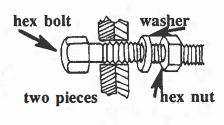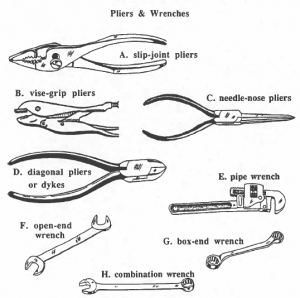Lesson 4: Pliers and Wrenches
WORD LIST
|
1. kind |
a group of things that have common characteristics. Like the word type. Example: what kind of tool should I use? |
|
2. type |
a class or group that has common characteristics. Like the word kind. Example: Dykes are a type of pliers. |
|
3. grip |
to hold firmly (tightly and strongly). Example: Martin gripped the wrench tightly. |
|
4. needle |
a small, thin piece of steel with a sharp point and a hole for thread. Example: she sewed socks with a needle and thread. |
|
5. set |
a group of things that are used together. Example: a set of wrenches all look similar, but are of different sizes. |
|
6. size |
how long, or how big something is; something’s dimensions. Example: this wrench is too small; get a bigger size. |
|
7. pound |
to hit something repeatedly using something heavy. Example: Pablo is pounding the pipe with a hammer. |
|
8. hex |
|
|
9. washer |
|
|
10. scratch |
to mark or cut a surface with something sharp. Example: using pliers to untighten a bolt will scratch the bolt. |
CROSSWORD PUZZLE
The Use of Pliers and Wrenches
In this lesson you will learn the names of four kinds of pliers and four types of wrenches. You will also learn for what they are used, their purposes.
Pliers is a plural word, so when you speak about them, you should say “the pliers are…” or “the pair of pliers is…”. In this last phrase the word pair is singular.
Pliers are holding tools, usually made from two pieces of strong metal, fastened in the middle, with jaws at one end, and handles at the other. There are several kinds of pliers:
1. Slip-joint pliers: These pliers have two positions for the handles. In one position the jaws can be opened wider than in the other position. These pliers can be used to grip metal parts or other things.
2. Vise-grip pliers: This pair of pliers is like a vise or a clamp, because a machinist can tighten them around something and then lock them in place like a vise.
3. Needle-nose pliers: They are used to hold small objects or to reach into narrow places. These pliers get the name “needle-nose” because the jaws (nose) are long and thin, like a needle.
4. Diagonal pliers: They have two sharp cutting edges instead of two holding jaws. They are good for cutting wire or small, light pieces of metal, or for stripping insulations away from wire.
Wrenches are tools for tightening and loosening nuts and bolts. They can be brought one at a time, but are usually sold as a set of wrenches with a variety of sizes, from small to large. The size of a wrench is measured by how wide the gripping end of the wrench is.
The units of measuring wrench sizes are either in U.S. standard units (inches) or in metric units (millimeters). There are several types of wrenches which we will read about on the next page.
1. Open-end wrench: This wrench has two ends which are open; these ends will fit easily around a nut or a bolt. The two ends of an open-end wrench are usually of different sizes, so you have two tools in one.
2. Box-end wrench: This wrench has two ends which are closed, like a box. The end of this wrench must be fit over and down onto the nut or bolt. The advantage of this kind of wrench is that it gives a very tight grip.
3. Combination wrench: This wrench has one open end and one box end, a combination, like a combination plate at the restaurant–one taco, one enchilada, one serving of rice. The two different ends of the combination wrench are usually the same size.
4. Pipe wrench: This wrench has jaws that are adjustable to fit a variety of sizes; the jaws also have teeth that will grip tightly. When pressure is put on the handle, the teeth will hold more tightly.
Note 1
Note 2: Nuts, Bolts, and Washers

The most common kind of nut is a hex nut. “Hex” means “six” and tells you that there are six sides on this nut.
The bolt shown below is a hex bolt, because it has a head with six sides. The wrenches we have been talking about fit over these hex nuts and hex bolts.
In the bottom picture, you can see two pieces of material that are held together by a hex bolt and a hex nut. There is also a washer, next to the nut; it gives a tight fit and prevents the piece from being scratched.

Word Practice 1

Word Practice 2, 3, 4



WHERE ARE THE TOOLS?
Below is a picture of some shelves in a tool room. Learn the words that help to locate things – words like “on the top shelf, in the middle”.  Practice with another student. Both of you look at the picture. One student will ask you questions about where the tools are. Tell the student, using the location words from the page.
Practice with another student. Both of you look at the picture. One student will ask you questions about where the tools are. Tell the student, using the location words from the page.
Where are the tools?
With the picture of the shelves in front of both of you, practice the questions and answers with another student; that person holds the question and answer sheet, asks you the questions, listens to you answers, and tells you if your answer is correct.
- Print the Shelf Page: 3.4 Shelf
- Print the Question and Answer Sheet: 3.4 Questions and Answers
Reading Comprehension
End-of-Lesson Questions
Part A: Listen to the recording. Type the correct capital letters next to the numbers.
Click here to listen to the recording.

Part B: Identify the tool names

Part C: Answer the questions

 six; a short word for hexagonal (having six angles and six sides). Example: a hex nut has six equal sides and six equal angles.
six; a short word for hexagonal (having six angles and six sides). Example: a hex nut has six equal sides and six equal angles. a flat ring of metal or rubber that seals and protects in a joint. Example: put a washer on the bolt before you put on the nut.
a flat ring of metal or rubber that seals and protects in a joint. Example: put a washer on the bolt before you put on the nut.